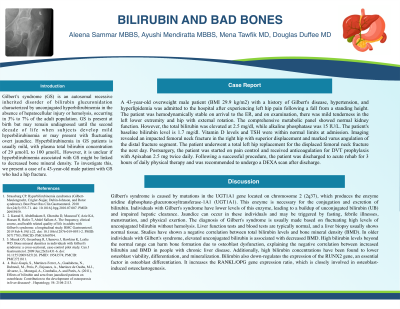Sunday Poster Session
Category: Biliary/Pancreas
P0194 - Bilirubin and Bad Bones
Sunday, October 27, 2024
3:30 PM - 7:00 PM ET
Location: Exhibit Hall E

Has Audio

Aleena Sammar, MBBS
Parkview Medical Center
Pueblo, CO
Presenting Author(s)
Aleena Sammar, MBBS, Ayushi Mendiratta, MBBS, Mena Tawfik, MD, Douglas Duffee, MD, Christopher Calcagno, DO, PharmD
Parkview Medical Center, Pueblo, CO
Introduction: Gilbert’s syndrome (GS) is an autosomal recessive disorder characterized by unconjugated hyperbilirubinemia in the absence of liver injury or hemolysis. It affects 3-7% of adults and is present at birth but may remain undiagnosed till the second decade of life until mild hyperbilirubinemia or overt jaundice develops. Hyperbilirubinemia is usually mild, with total bilirubin concentration of 29 μmol/L to 100 μmol/L. However, it's uncertain whether this condition is linked to lower bone density. To investigate this, we present a case of a 43-year-old male with GS who had a hip fracture.
Case Description/Methods: A 43-year-old overweight (BMI 29.9 kg/m2) male patient with a history of GS was admitted to the hospital after a fall from a standing height, leading to a left femoral neck fracture. Lab studies showed an elevated total bilirubin at 2.5 mg/dl, Vitamin D levels of 42 ng/mL, and alkaline phosphatase of 15 IU/L. The patient's baseline bilirubin level is 1.7 mg/dl. Imaging revealed an impacted femoral neck fracture in the left hip with superior displacement and marked varus angulation of the distal fracture segment. The patient underwent a total left hip replacement and was discharged following a successful procedure. A DEXA scan was recommended at discharge.
Discussion: Gilbert's syndrome is caused by mutations in the UGT1A1 gene, leading to lower levels of the enzyme uridine diphosphate-glucuronosyltransferase. This results in the buildup of unconjugated bilirubin (UB). Fasting, febrile illnesses, menstruation, and physical exertion can trigger jaundice in individuals with this syndrome. The diagnosis of Gilbert's syndrome is usually made based on fluctuating levels of UB without hemolysis. Liver function tests and biopsy are usually normal. Studies have shown a negative correlation between total bilirubin levels and bone mineral density (BMD). In older individuals with Gilbert's syndrome, elevated UB is associated with decreased BMD. High bilirubin levels beyond the normal range can harm bone formation due to osteoblast dysfunction, explaining the negative correlation between increased bilirubin and BMD in people with chronic liver disease. High bilirubin concentrations have also been found to lower osteoblast viability, differentiation, and mineralization. Bilirubin also down-regulates the expression of the RUNX2 gene, an essential factor in osteoblast differentiation. It increases the RANKL/OPG gene expression ratio, which is closely involved in osteoblast-induced osteoclastogenesis.
Disclosures:
Aleena Sammar, MBBS, Ayushi Mendiratta, MBBS, Mena Tawfik, MD, Douglas Duffee, MD, Christopher Calcagno, DO, PharmD. P0194 - Bilirubin and Bad Bones, ACG 2024 Annual Scientific Meeting Abstracts. Philadelphia, PA: American College of Gastroenterology.
Parkview Medical Center, Pueblo, CO
Introduction: Gilbert’s syndrome (GS) is an autosomal recessive disorder characterized by unconjugated hyperbilirubinemia in the absence of liver injury or hemolysis. It affects 3-7% of adults and is present at birth but may remain undiagnosed till the second decade of life until mild hyperbilirubinemia or overt jaundice develops. Hyperbilirubinemia is usually mild, with total bilirubin concentration of 29 μmol/L to 100 μmol/L. However, it's uncertain whether this condition is linked to lower bone density. To investigate this, we present a case of a 43-year-old male with GS who had a hip fracture.
Case Description/Methods: A 43-year-old overweight (BMI 29.9 kg/m2) male patient with a history of GS was admitted to the hospital after a fall from a standing height, leading to a left femoral neck fracture. Lab studies showed an elevated total bilirubin at 2.5 mg/dl, Vitamin D levels of 42 ng/mL, and alkaline phosphatase of 15 IU/L. The patient's baseline bilirubin level is 1.7 mg/dl. Imaging revealed an impacted femoral neck fracture in the left hip with superior displacement and marked varus angulation of the distal fracture segment. The patient underwent a total left hip replacement and was discharged following a successful procedure. A DEXA scan was recommended at discharge.
Discussion: Gilbert's syndrome is caused by mutations in the UGT1A1 gene, leading to lower levels of the enzyme uridine diphosphate-glucuronosyltransferase. This results in the buildup of unconjugated bilirubin (UB). Fasting, febrile illnesses, menstruation, and physical exertion can trigger jaundice in individuals with this syndrome. The diagnosis of Gilbert's syndrome is usually made based on fluctuating levels of UB without hemolysis. Liver function tests and biopsy are usually normal. Studies have shown a negative correlation between total bilirubin levels and bone mineral density (BMD). In older individuals with Gilbert's syndrome, elevated UB is associated with decreased BMD. High bilirubin levels beyond the normal range can harm bone formation due to osteoblast dysfunction, explaining the negative correlation between increased bilirubin and BMD in people with chronic liver disease. High bilirubin concentrations have also been found to lower osteoblast viability, differentiation, and mineralization. Bilirubin also down-regulates the expression of the RUNX2 gene, an essential factor in osteoblast differentiation. It increases the RANKL/OPG gene expression ratio, which is closely involved in osteoblast-induced osteoclastogenesis.
Disclosures:
Aleena Sammar indicated no relevant financial relationships.
Ayushi Mendiratta indicated no relevant financial relationships.
Mena Tawfik indicated no relevant financial relationships.
Douglas Duffee indicated no relevant financial relationships.
Christopher Calcagno indicated no relevant financial relationships.
Aleena Sammar, MBBS, Ayushi Mendiratta, MBBS, Mena Tawfik, MD, Douglas Duffee, MD, Christopher Calcagno, DO, PharmD. P0194 - Bilirubin and Bad Bones, ACG 2024 Annual Scientific Meeting Abstracts. Philadelphia, PA: American College of Gastroenterology.
